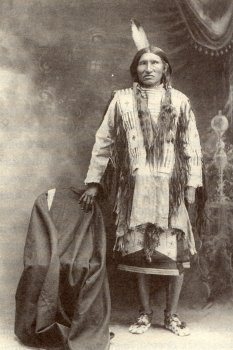Kicking Bear facts for kids
Quick facts for kids
Kicking Bear
|
|
|---|---|
| Matȟó Wanáȟtake | |
 |
|
| Oglala Lakota who became a band chief of the Minneconjou Lakota Sioux leader | |
| Personal details | |
| Born | March 18, 1845 Pine Ridge Indian Reservation, South Dakota, U.S.A. |
| Died | May 28, 1904 (aged 59) Manderson-White Horse Creek, South Dakota, U.S.A. |
| Spouse | Woodpecker Woman |
| Relations | Flying Hawk (brother) Black Fox II (half brother) Crazy Horse (first cousin)) |
| Parents | Black Fox (Great Kicking Bear) and Iron Cedar Woman |
Kicking Bear (Lakota: Matȟó Wanáȟtaka) was an important Lakota leader. He was born on March 18, 1845, and passed away on May 28, 1904. He belonged to the Oglala branch of the Lakota people. Later, he became a band chief of the Miniconjou Lakota Sioux.
Kicking Bear was a brave warrior. He fought in many battles alongside his brother, Flying Hawk. His first cousin, Crazy Horse, was also a famous warrior. They fought together during the War for the Black Hills. One of the most well-known battles was the Battle of the Greasy Grass.
Contents
Honoring Crazy Horse
In 1877, Kicking Bear took part in a special ceremony. This was called the Last Sun Dance. It was held to honor his cousin, Crazy Horse. The ceremony happened one year after the Lakota victory at the Battle of the Greasy Grass. People offered prayers for Crazy Horse during this important time.
Warrior Cousins
Kicking Bear was one of five warrior cousins at the Sun Dance. They showed their bravery and respect for Crazy Horse. The cousins included Kicking Bear, his brother Flying Hawk, and their half-brother Black Fox II. The other two cousins were Eagle Thunder and Walking Eagle. These men were known as strong and respected warriors.
The Ghost Dance Movement
Kicking Bear was also a holy man. He played a big part in the Ghost Dance religious movement. This movement became popular around 1890. Kicking Bear traveled with another Lakota man, Short Bull. They went to visit Wovoka, who was the leader of the Ghost Dance. Wovoka was a Paiute holy man living in Nevada.
Bringing the Ghost Dance to the Lakota
Kicking Bear, Short Bull, and Wovoka helped bring the Ghost Dance to the Lakota people. Many Lakota were living on reservations in South Dakota at this time. The Ghost Dance offered hope and comfort to them.
Life After the Ghost Dance
After the death of Sitting Bull, Kicking Bear and Short Bull were held in prison. They were kept at Fort Sheridan, Illinois. They were released in 1891.
Touring with Buffalo Bill
After their release, Kicking Bear and Short Bull joined Buffalo Bill Cody's Wild West Show. They traveled with the show in Europe. This experience was difficult for Kicking Bear. After a year of touring, he returned home. He went back to the Pine Ridge Reservation to be with his family.
Speaking for His People
In March 1896, Kicking Bear traveled to Washington, D.C.. He was one of three Sioux delegates. They went to speak with the Bureau of Indian Affairs. Kicking Bear shared his concerns about traders on the reservation. He wanted Native Americans to have more control over their own lives.
While in Washington, Kicking Bear agreed to have a life mask made. This mask would be used for a sculpture of a Sioux warrior. It was to be displayed in the Smithsonian Institution's National Museum of Natural History.
An Artist's Account
Kicking Bear was also a talented artist. In 1898, he painted his own story of the Battle of Greasy Grass. He did this at the request of artist Frederic Remington. This painting was made more than twenty years after the battle.
Kicking Bear passed away on May 28, 1904. He was buried with an arrowhead. This symbolized his desire to bring back the old ways of his people. His burial place is near Manderson-White Horse Creek.
Images for kids
-
Sculpture from life mask of Kicking Bear by Alexander Phimister Proctor, on Q Street Bridge, Washington, D.C.
See also
 In Spanish: Kicking Bear para niños
In Spanish: Kicking Bear para niños


